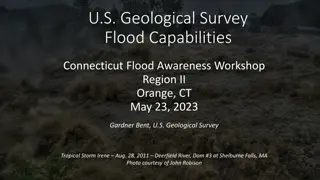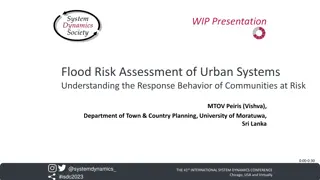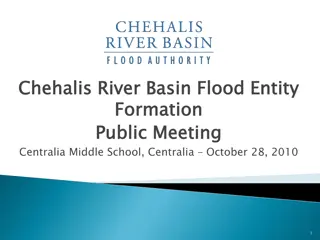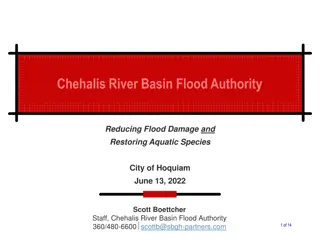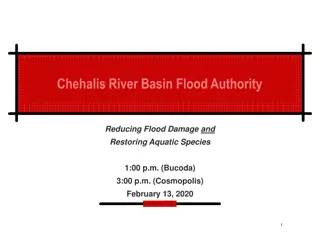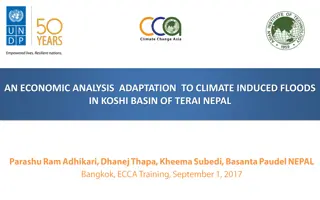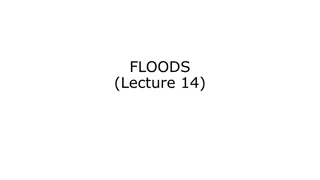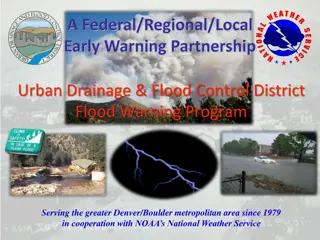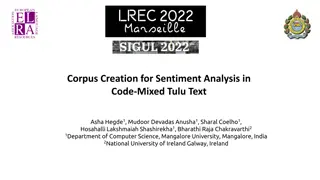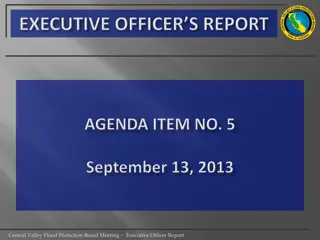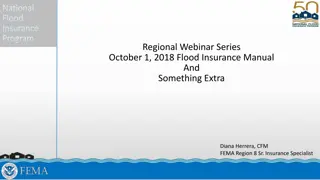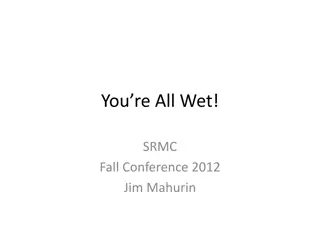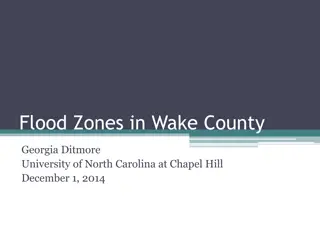Understanding Mixed Populations in Flood Frequency Analysis
In this presentation by Gregory S. Karlovits, P.E., PH, CFM, a statistical hydrologist from the US Army Corps of Engineers, the focus is on modelling mixed populations in flood frequency analysis. The key topics include revisiting the IID assumption, identifying mixed populations, and building models for these populations. The importance of homogenizing frequency analyses is highlighted, along with the distinction between populations and samples. The assumptions, challenges, and considerations related to independence and identical distribution in hydrologic processes are discussed, emphasizing the use of sample statistics to estimate population parameters.
Download Presentation

Please find below an Image/Link to download the presentation.
The content on the website is provided AS IS for your information and personal use only. It may not be sold, licensed, or shared on other websites without obtaining consent from the author. Download presentation by click this link. If you encounter any issues during the download, it is possible that the publisher has removed the file from their server.
E N D
Presentation Transcript
Modelling Mixed Populations Flood Frequency Analysis PROSPECT May 2022 Gregory S. Karlovits, P.E., PH, CFM Statistical Hydrologist US Army Corps of Engineers Hydrologic Engineering Center
Purpose Review iid random variables Identify mixed populations in flood frequency analysis Build a model for a mixed population Overall: Take steps toward homogenizing frequency analyses
Outline 1. Revisiting the IID assumption 2. Understanding mixed populations 3. Modelling mixed populations
Populations vs. Samples Population Entire group you want to draw conclusions about May be unknowable Parameter Sample Part or subset of the population Data you have or can collect Statistic Example: all annual maximum flows on the Mississippi River at Vicksburg Example: annual maximum flow observations on USGS/NWIS
Assumptions Sample is representative Observations are IID Independent Identically-Distributed S 7
Independence Serial (in)dependence? Hydrologic processes have long memories Overcount certain ranges of observation
Independence Generally safe by using annual maximum series Consequence may be small Depends on strength of serial dependence Depends on the sample size
Identical Distribution A probability distribution represents the relative likelihood of all outcomes in a population Each sample in a record of streamflow is assumed to come from the same population Identical distribution = same population
Inference We want to ask questions of an unknowable population We use sample statistics to estimate population parameters Observation Sample Population sx2 Inference
Identical Distribution Are all floods created equal? Just because a flow is an annual maximum, does not guarantee it was created the same way as the others
Observation Population A Sample Inference? Observation Population B
Mixed Populations Some locations unfortunate enough to have multiple causes for flooding What are hydrological and meteorological factors for explaining flood variability?
Flood Variability Snow vs. rain Meteorological scale Moisture source Season Long-term climatic impacts Wildfire
Snow vs. Rain Boreal or high-elevation watersheds may accumulate snow Warmer regions in same watershed may have rain floods at the same time Snow melts later Sometimes, rain falls on snowpack
Meteorological Scale Storm Duration Mesoscale ~6 hour Synoptic ~48 hour
Climatic Cycles https://www.nature.com/articles/srep06651/figures/3
Post-Wildfire Hydrology & Debris Flow: Significant Long-Term Effects on Hydrological Processes Burned Canopy/Vegetation Decrease roughness & canopy storage capacity Early snowmelt by reducing canopy shade areas Hydrophobic Soil Layer Decrease the soil infiltration loss rate Increase the surface runoff volume More rapid runoff Radically change the Hydrologic response: Rapid Runoff/Flash Floods & Large Runoff Volume Peak Timing, Flow, and Discharge Volume including Debris Double Impacts: Rain on snow on burn areas Subsequent Issues: Streambank Erosion, Reservoir volume Reduction, Water Quality, & Ecosystem Hydrologic models are used to estimate post-wildfire hydrology and debris yield/flow
High Park Fire (June-July, 2012), Colorado Estimated pre-and post-fire hydrographs Source: USGS NRCS Hydrology Technical Note 4 -Hydrologic Analyses of Post-Wildfire Conditions, August 2016
HEC-HMS results, 100-year peaks at Glenwood (NM), areal reduction 6-hm centering Source: USGS NRCS Hydrology Technical Note 4 -Hydrologic Analyses of Post-Wildfire Conditions, August 2016
Burn Scenario 3 Source: Modeling The Impacts of Wildfire On Surface Runoff In The Upper Uberabinha River Watershed Using HEC-HMD, JUEE, v.11, n.1, p.88-98 Burn Scenario 1 Burn Scenario 2
Multiple Events Sequencing of events may cause the biggest floods
6 10 Annual Nonhurricane Events 1929-85 Computed Frequency Curves, Nonhurricane Series Annual Hurricane Events, 1929-85 Graphical Frequency Curve, Hurricane Series 5 10 Flow (cfs) 4 10 Many zero years 3 99.99 99.9 10 0.1 90 1 99 50 10 0.01 % Chance Exceedance
Identifying Mixed Populations Streamflow data by itself usually not enough information Need additional data to identify causal mechanism Climatological data most important Sometimes simple rules work well
Nonstationarity Both mixed populations and nonstationarity deal with differences in the properties of floods Key difference: nonstationarity is a one-way process
A Model for Mixed Populations If C = max(A,B), then: Any flood magnitude CDF A: largest rain flood in a year B: largest snow flood in a year C is the larger of the two Thus, C is the annual maximum
A Model for Mixed Populations What does this require? Determining the dominant flood mechanisms/types Identifying the annual maximum series for each type Fitting a distribution to each AMS
Flood A Flood B
Flood B AMS (all) Flood A
Sample Sizes Splitting the annual maximum series by type can result in small sample sizes for each flood type Consider applying peaks-over-threshold







